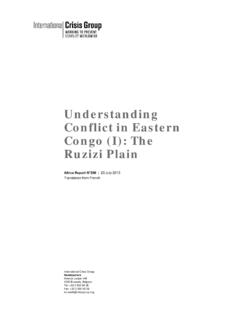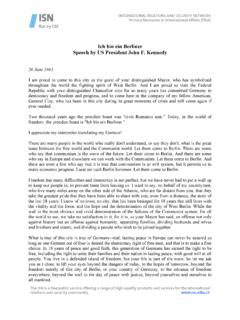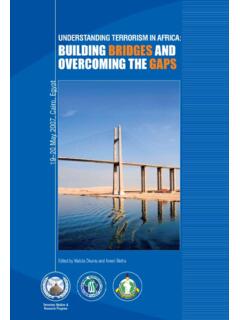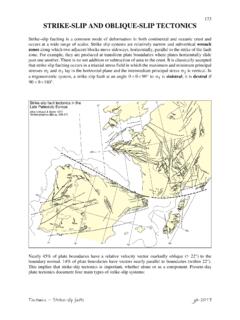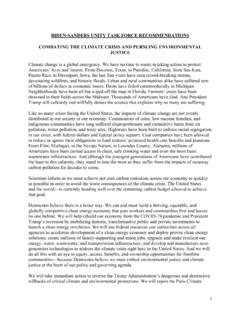Transcription of Pakistan's Energy Crisis: Causes, Consequences and ...
1 Expert Analysis January 2014. Pakistan's Energy crisis : causes , Consequences and possible remedies By Safiya Aftab Executive summary The Energy crisis is the largest single drain on Pakistan's economy. This crisis stems from a fuel mix transformation initiated two decades ago, when power generation came to rely more on imported furnace oil than hydropower. The resultant increased power generation costs, coupled with the high proportion of line losses, have led to the need to increase tariffs, while causing losses to power generation, transmission and distribution companies. This in turn has given rise to the phenomenon of circular debt in the Energy sector, whereby slippages in the payment of bills (particularly on the part of public institutions) trigger a chain of delayed payments for im- ported furnace oil, natural gas or other inputs to the thermal generation system, which in turn hamper the operation of the power plants and result in less than optimum capacity usage.
2 In addition, the Energy crisis is a significant drain on the government's resources, with Energy sub- sidies taking up a substantial part of the federal budget. Under an International Monetary Fund agreement of September 2013 the government is committed to clearing the circular debt, adjust- ing tariffs to improve resource allocation and encourage conservation, and implementing fuel policies aimed at ensuring natural gas supplies to power plants. Introduction Pakistan. It focuses particularly on the new Energy policy According to the Ministry of Finance, the Energy crisis is issued by the government that came to power in May 2013. the largest single drain on Pakistan's economy, shaving off up to 2 percentage points from annual gross domestic The following sections delineate the origins of the Energy product growth in the country (see EAW, 2013: Overview ).
3 crisis and some of the key issues that the government is The current Energy crisis began to manifest itself in currently grappling with. The expert analysis then goes on earnest by late 2007. Although the causes of the crisis are to look at the solutions that the government is trying to structural, the immediate trigger was the 2007 global implement and assesses whether these will indeed prove commodity price boom, when oil prices almost tripled over to be effective in reducing Energy shortages and reviving an 18-month The unprecedented fuel inflation was growth. a key factor in the 36% increase in Pakistan's import bill in fiscal year 2008 (see EAW, 2013: Statistical appendix , Origins of the crisis Table ), and the Consequences of an Energy generation While 2007 is considered the starting point of the ongoing policy that relies heavily on oil-fired thermal generation Energy crisis , the issue has its roots in policy decisions became all too clear.
4 Taken two decades ago. In 1994, when only 40% of the population had access to electricity, Pakistan was facing This expert analysis briefly discusses the key issues power shortages of about 2,000 MW during peak load times affecting the Energy sector, and then analyses how Energy (Pakistan, 1994). The government of the day assessed that issues are having an impact on growth and development in the average annual increase in power demand would be 1 Global fuel prices averaged $50 per barrel at the beginning of 2007 and peaked at $147 per barrel in July 2008. Noref Expert Analysis January 2014. about 8% in the short to medium term, and generation Circular debt capacity of the order of 960-1,300 MW would have to be The increased dependence on expensive, thermal oil power added to the system annually from the mid-1990s onwards generation has also given rise to the phenomenon of to meet the demands of a growing economy.
5 The scale of circular debt in the Energy sector, in terms of which investment required was deemed to be well beyond what slippages in bill payments (particularly on the part of public the public sector could muster. institutions) trigger off a chain of delayed payments for imported furnace oil, natural gas or other inputs to the A power policy was thus issued in 1994 that offered an thermal generation system, which in turn hamper the attractive package of incentives to foreign investors, including operation of the power plants and result in less than a tariff ceiling that resulted in returns on investment of optimum capacity usage. As of the end of July 2013 the 15-18%, a minimum required equity investment of just 20%, circular debt had increased to almost $5 billion, and was and a host of fiscal and security incentives (for details, see being cited as a significant drag on the power sector and a Pakistan, 1994).
6 More importantly, the policy effectively key factor impeding the efficient operation of independent transformed the fuel mix for Energy generation in the country. power producers (IPPs). In the 1980s a little over 60% of Pakistan's power was generated from hydropower. The 1994 power policy, on the The new government that came to power in June 2013 cited other hand, was designed to encourage the quick installation the retirement of the circular debt as a priority, and within of thermal power plants, the bulk of which were fuel oil five weeks of taking office announced that it had taken based. The government of the time considered this strategy to measures to deal with the issue. The debt was cleared by be the optimal one, not only because of the relative ease with paying Rs. 161 billion in cash to IPPs, issuing Pakistan which thermal power plants could be added to the generation investment bonds to public sector entities responsible for mix compared to hydropower resources, which would take oil and gas exploration and the marketing of petroleum much longer, but also because key proposed hydropower products, and making non-cash payments to the Water projects, for which feasibility studies had been prepared, were and Power Development Authority (WAPDA the country's controversial for political By 2013, however, the largest power supply utility) and the National Transmission proportion of power generation from hydro and nuclear sourc- and Distribution Company (NTDC).
7 4 Questions were raised es was about 36%, while the proportion of generation from regarding the government's ability to raise funds for the furnace oil-fired sources was almost equal at 35% (EAW, payments to IPPs in particular (as these were cash pay- 2013: Table ). Gas-fired plants accounted for 29% of power ments), but the finance minister claimed that the monies generation, while coal-fired plants accounted for a minuscule were put together through cuts in non-salary expenditure of generation. Thus, in less than two decades the fuel in some sectors, by raising money from national savings mix for power generation underwent a significant transforma- schemes and by taking loans from domestic banks. tion. Until more detailed economic data is available, it will not be Current issues clear what the government did to raise money for the The key fiscal issues around the Energy crisis currently retirement of the debt.
8 But each of the measures cited by being experienced by the Pakistani economy are discussed the minister has longer-term implications from an below. increase in the domestic debt burden to the curtailment of essential expenditure on services. Nevertheless, there is Fuel mix: cost implications little doubt that the previous government's inaction on the The fuel mix transformation described earlier has cost debt was costing the economy dearly, and the issue had to implications, because power generation from imported be tackled head on. The government now needs to start furnace oil is significantly more expensive than from hydro looking at the larger structural problem, that on sources approximately Rs. 12-17 per unit of oil power average power costs about Rs. 12 per unit to generate, generation, compared to hydro generation, which costs while end users pay Rs.
9 9. Unless this fundamental issue of about Rs. 1 per unit (see Pakistan, 2013).3 Generation from Energy bills not covering costs is addressed, the debt will diesel-fired power plants is even more expensive at about rear its head again, and sooner rather than later. Indeed, it Rs. 23 per unit of power generated. has already done so by the end of September 2013, in a statement to the National Assembly, the Treasury admitted The increased generation cost, coupled with the high that circular debt of Rs. 100 billion (or nearly $1 billion) had proportion of line losses (estimated in the National Power once again accumulated in the power sector (Daily Business Policy 2013 at 23-25%; see Pakistan, 2013) ensures that Recorder, 2013). power supply costs are close to Rs. 16 per unit (or about $ ) in Pakistan, compared to about $ for the Asia-Pacific region as a whole (see OECD, 2010).
10 2 The most obvious example is the proposed Kalabagh Dam, which is opposed by stakeholders in the provinces of Khyber Pakhtunkhwa and Sindh for a variety of techni- cal and administrative reasons. 3 The dollar/rupee exchange rate is roughly 107 rupees to the dollar. 4 These consisted of adjustment of payables against receivables essentially book adjustments. 2. Noref Expert Analysis January 2014. Subsidies public sector entities, in addition to households. These Energy subsidies constituted 95% of the subsidies that the instances of non-payment of dues have reverberated right government provided in the budget for the last fiscal year through the supply chain, causing IPPs to operate at less (2012-13),5 amounting to of current expenditure. than optimum capacity, thus precipitating a power crisis .

